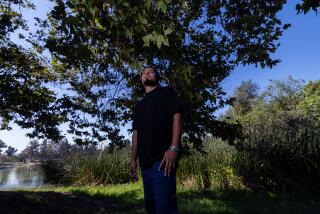Saving the Biomes From Man LIFE IN THE BALANCE<i> by David Rains Wallace (Harcourt Brace Jovanovich: $29.95; 366 pp., illustrated) </i>
- Share via
This past summer saw the National Audubon Society sell conservation to America through a series of special television documentaries on PBS. Robert Redford narrated the sad but not yet hopeless story of the California condor; Dennis Weaver told of building common ground between farming and wildlife; Loretta Swit described the efforts to preserve panthers and cheetahs. This fall, the series will continue on Turner Broadcasting’s WTBS.
A companion to the television specials is the Audubon Society’s book, “Life in the Balance,” by respected nature writer David Rains Wallace. This Californian’s previous works, “The Klamath Knot” and “The Dark Range,” have been well received, but the task his editors gave Wallace here was surely daunting. The television specials have been case histories of troubled, appealing animals whose prospects, while grave, are not hopeless if people make the effort to conserve them. The companion volume is no “based on the TV series” gimmick. This book ranges beyond case histories to the Earth’s fundamental biomes--the grasslands, forests, deserts, oceans, rivers--to attempt a kind of health report, to explain how present conditions got this way and to search for ways we may mitigate or reverse the most serious problems of each system. And it still includes examples to illustrate its points. That’s a great deal of ground to cover in fewer than 400 pages, especially when those pages also contain more than 100 photographs (half in color) and are laid out for high graphic appeal.
A case in point: One Audubon television special dealt with the black-footed ferret, a creature reduced to one colony of a few dozen, with another handful in captivity for an attempt at breeding. The urgent issues are control of diseases, such as distemper, that decimate ferret colonies; finding the magic conditions that will persuade the captives to breed, and protecting the last colony from outside perils. But the real long-term issues, the ones Wallace presents in his book, date back to the invention of agriculture. Grasslands are among the most productive places on Earth. The grains that grow there not only supported that big game that early man used as his principal sustenance but after the game was exterminated provided food directly. The first efforts at planting this grain were probably in cleared forest--and vast areas of the world’s forests have been cleared for such agriculture. Once people had learned how to cope with the dense sod and the drier conditions of the grasslands, wild was converted to tame.
Creatures such as the black-footed ferret evolved under conditions in which the grassland resource was vast. If individual colonies were lost because of disease or because the prairie dog on which ferrets feed died out, that was no consequence to either species because both prairie dogs and ferrets could easily re-colonize elsewhere. When the grassland was reduced to small, isolated patches, this strategy no longer worked. And it worked even less when prairie dogs were actively poisoned out where they did survive.
The lesson, in various permutations, applies not only to black-footed ferrets but to other grassland animals all over the world. There are partialpalliatives, some already well established. Africa and, to a lesser extent, Asia have set aside a few fair-sized grasslands as parks and preserves. The United States is still discussing some sort of Prairie National Park. Finding a piece of virgin or restorable grassland large enough to support bison, elk and wolves as well as all the other creatures in a free-functioning ecosystem is doubtful, but some managed preserve is a realistic possibility.
Continuing the lesson, Wallace observes that high-technology “clean farming” of the ‘60s and ‘70s was devastating to creatures that had subsisted in the back corners and hedgerows of an earlier, less urgent agriculture. Ironically, some farmers are now tentatively exploring the economics of leaving some land fallow, reducing their use of pesticides--even eliminating plowing. Ranchers have found that it often makes economic sense to encourage pronghorns, deer, even bison to use rangeland, for if properly managed and not overgrazed by domestic stock (as most of the West’s public lands are), rangeland as a habitat for wildlife can yield more income through hunting permits than it can from an increased burden of cattle. Farm ponds can do the same with waterfowl and fish. In East Africa, game ranching for meat has succeeded where there is sufficient knowledge of the underlying biology. Somehow, economics, conservation and our increasingly sophisticated ecological understanding should be able to find common ground to hang on to bits of wild grasslands, and other biomes.
With the exception of the polar regions (which Wallace also covers), every system on Earth has been heavily exploited and profoundly depleted by human occupation and consumption. The variation in effects is interesting. The temperate forests and grasslands, among the first to be heavily utilized, have been the most profoundly altered, but they benefit from moisture, temperature and nutrient conditions that also make them the most resilient. Mountain systems, with their thinner soils and shorter growing seasons, are much more fragile but have been far less exploited; they have been a favorite for setting aside as parks. Deserts are also extremely fragile, and conversion from traditional nomadic occupation to continual use has typically exhausted their limited resources. The tropical forests were an impenetrable world until a few decades ago; now they are falling at rates of more than 1% per year, and the losses to the world’s biota--including many birds that summer in the temperate zone--are profound. The oceans continue to give up new fish resources that in turn affect marine mammals, and now pollution of the oceans themselves is becoming a phenomenon.
“Life in the Balance” is designed to be a kind of highly approachable primer to global conservation, and it is that. The information it presents is shallow--unavoidable in such a broad-brush treatment--and occasionally misleading or in error, also probably unavoidable. Although Wallace makes every effort to be upbeat, to teach the lesson that nature can be saved and is worth saving, the sickening destruction that our species has wrought and continues to wreak on this planet is hard to present cheerfully. If you can get past the pain, this is an enjoyable read and an excellent argument for conservation.
More to Read
Sign up for our Book Club newsletter
Get the latest news, events and more from the Los Angeles Times Book Club, and help us get L.A. reading and talking.
You may occasionally receive promotional content from the Los Angeles Times.









